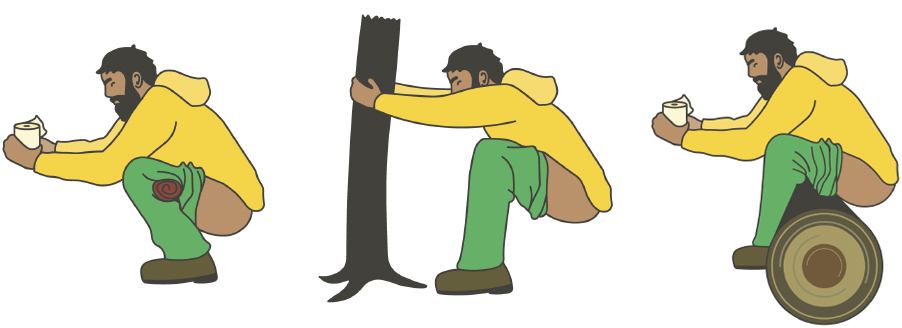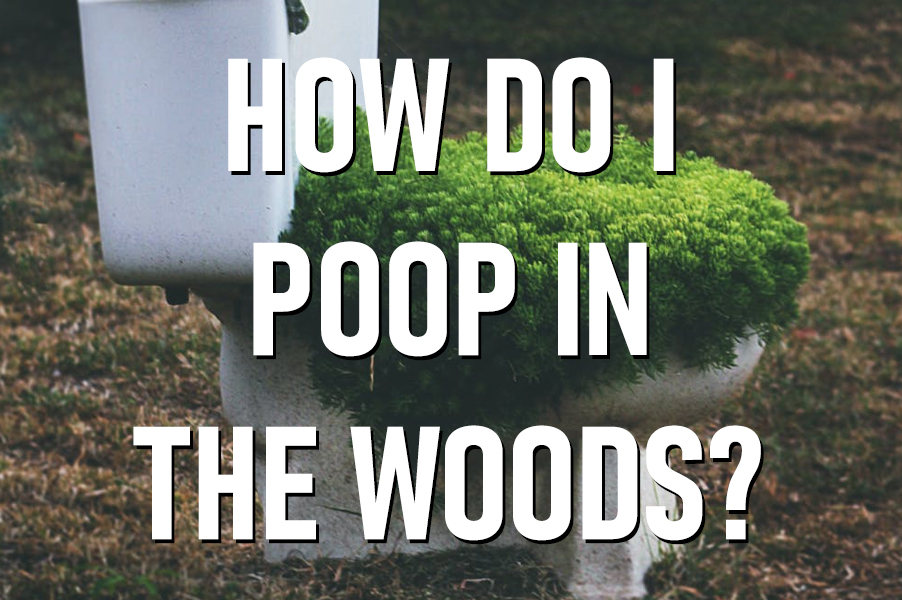Does a bear poop in the woods? Yes, and so do I!
I believe that one of the biggest issues holding back most people from dispersed camping is the idea of squatting in the woods like some sort of prehistoric Cro-Magnon person. This is unappealing to most, to say the least. But I have good news for you: It’s not nearly as barbaric as you think.
THE SCOOP ON GOING POOP
For most, #2 has to be the most stigmatized “movements” to have need for, while camping in the wilderness. Thankfully we have options. But, before we address those options, we need to address the rules and common practices.
For starters, using the Leave No Trace principles are the best practice for your dispersed camping in general but even more for proper waste disposal. Human waste can attract animals, spread disease, and pollute water sources if not disposed of properly. This is not to mention that no one, I mean no one, wants to see or smell what you ate yesterday, nor does anyone desire to have a ball of soiled toilet paper blowing through camp like a tumbleweed across main street in an old western. Simply consider everyone who is going to hike and camp after you as well as the animals who call the outdoors home.
LOCATION, LOCATION, LOCATION.
The first step in the process is to choose your spot. This can vary and depend highly on the local flora and fauna. So lets dive in.
The first consideration you need to have is the proximity to trails, roads, water sources and potential or probable camp sites. Try to locate your disposal site at least 200 feet (about 70 adult paces) from any of these places. Consider wind directions as well. You may thing your poop doesn’t stink, but its likely not the case.
Finding a stump or boulder to lean on, a tree to grab ahold of, or fallen log to sit over is optimal. Cover is also a consideration for those of you with a shy bladder or if you are around other campers. Bushes and low hanging branches proved good cover. Walls of boulders or large stands of trees are optimal to conceal your private moment. But if you are a “desert rat” like I tend to be, there is often scant cover to be found. Thankfully companies like Abco Tech have you covered, literally. Pop-up-privacy tents are great options and very easy to set up and take down.
Now depending on your environment and equipment, the soil matters. If you are running “fancier” gear, like the Alpcour portable toilet, You’ll just want to find some solid flat ground. If you are more the “rustic” type, you’ll want to find softer soil to dig in. The darker and richer the better. This allows for quicker and easier break down of the waste due a high (good) bacterial count in the soil. Digging near the base of trees may prove problematic due to the root systems of the tree. Try and dig at least two to three feet from the base of trees to avoid this problem.
PLAN YOUR POTTY TYPE
As previously mentioned, there seems to be a plethora of great options that most are unaware of. But have no fear, we at campinsiders.com are here to help you sort through all the bull…well, you know.
Our first, and most “au naturel” method is known as the “cat hole”. You may have heard of the cat hole’s bigger brother, the latrine. The cat hole is one of the most widely accepted methods of waste disposal in the back country. It consists of a hole, about six to eight inches deep and four to six inches wide. Bigger if your aim leaves something to be desired. This is typically a one time use hole, filled in when the job is done. The cat hole’s bigger brother, the latrine, is typically deeper and more representative of a trench. This is great for larger camps over multiple days. Typically the user will scoop in just enough dirt to cover the waste and mask the odor, leaving more trench behind for the next use. The latrine is then filled in completely before leaving the area. Personally, I always carry biodegradable toilet paper and a camp shovel in my Jeep. This makes for easy access to a forest lavatory any time I need one
Next, we have the portable toilet. This is where our options really expand. There are quite a few companies that make all sorts of portable toilet solutions. One thing to keep in mind with this solution is that you WILL BE REQUIRED to pack out your waste and dispose of it properly. You cannot bury the plastic bags that these toilets utilize, as they will not biodegrade. For some, packing up their own waste is too big of an ask. It is just something to consider when going this route. That being said, here are some options. One of my favorites is the good ‘ol 5 gallon bucket and bucket toilet seat, with waste bags. These aren’t your ordinary kitchen trash bag. They contain a powder that deodorizes and safely breaks down the waste. They reseal and allow you to safely toss them in any waste bin. But if a bucket isn’t bougie enough for you, then there are portable thrones like the afore mentioned Alpcour. It even has a manual spray device for personal cleaning. But keep in mind, this must be emptied into an approved sewage dump site or a little at a time into your home toilet.
Now the favorite option of most is the good old-fashioned pit toilet, or outhouse. There are some established sites on public lands that have these pit toilets. Maintenance can be hit or miss, and always be prepared to have your own T.P. The best way to find out if where you are going has an outhouse is to check the BLM or Forest Service websites for info. For example, just up the road from me there is a nice little free public camp area that does have toilets. You can check that page here to see an example of one that has toilets.
My least favorite option, though sometimes the only permissible option, is the “wag bag”. This method is often required of backpackers in national parks. Most national parks operate on a “pack it out” rule in the back country, where toilet access is simply not available. This consists of a disposable, one time use, waste bag that contains an odor neutralizing agent and enzymes to break down the waste. Be sure to check the regulations in whichever park you’re traveling through. Here is an example resource page for Mt. Whitney.
ASSUME THE POSITION

Nothing will ruin your relief time like burning quads and bad balance. So here are a few tips and positions for you cat hole and latrine users.
- First is the gold standard: the squat. I personally like to roll something up to put behind my knees for support. Grabbing the knees also helps with supporting your weight. Always make sure you are going to clear those pants.
- Next up is the “tree hugger” or “pole dancer”. Hold onto the tree for support and lean back. This offers more trouser clearance and a little better support.
- Lastly, we have my preferred method the “butt hang” or “cliff hanger”. A log, boulder, or whatever you can find may be used as a seat. Just be sure you are fully hanging off of the other end and have good clearance with the object you are sitting on.
Any of these are adequate and will get the job done. Physiologically, the squat is the best way to eliminate wastes, period. It puts things into alignment that were naturally made to be in that position.
A final note on position for those of you with kids too young to balance on their own. My wife and I have found the best solution is assisting the child into what is essentially a combination of all of these positions. For smaller children: after lowering their pants to the ankles (or removing them altogether), grasp their upper thighs just above the knees. Both of your thumbs should be facing outward with your other fingers behind their knees. Have them go into a squatting position, press their back to your chest, pulling their knees to their chest, and lift them over the cat hole. At this point you should have a wide stance—trust me on this one. Bend your knees and slightly at the hip and let them have at it. For larger kids, you’ll have them face you and wrap their arms around your neck, still holding the back of their knees, helping them stabilize in the squatting position. This may be embarrassing for some kids or uncomfortable for others. Practice the hold at home and talk about it before camping. If it is just not going to happen, then I recommend bringing one of the portable toilets I suggested.
Tidying Up
There are few things that will ruin a camping excursion like unintentionally wiping with poison oak. Be prepared. Carry toilet paper. I personally carry biodegradable paper, but standard household toilet paper will suffice. But you don’t have it, there are options.
Safe options:
Mules Ear (Wyethia Mollis)
Smooth stones
De-barked sticks
Moss
Unsafe options:
Stinging Nettle (Urtica Dioica)
Icy snow (it WILL cut)
Evergreen bark
Lastly, please be responsible and pack out any wipes (even if they are flushable) and any feminine products. These things are not easily biodegradable. You will find that some websites recommend packing out your t.p. This is not required if you use the t.p. sparingly and are able to burry it fully. It will biodegrade just fine in most environments; however, in the desert, it is recommended to pack it out, as the arid environment does not allow for decomposition as quickly as places that receive regular precipitation. Tread lightly. Keep our lands clean and useable for future generations.

